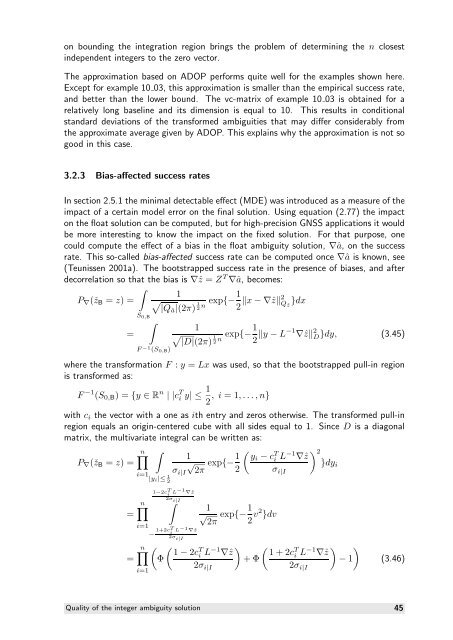The GNSS integer ambiguities: estimation and validation
The GNSS integer ambiguities: estimation and validation
The GNSS integer ambiguities: estimation and validation
You also want an ePaper? Increase the reach of your titles
YUMPU automatically turns print PDFs into web optimized ePapers that Google loves.
on bounding the integration region brings the problem of determining the n closest<br />
independent <strong>integer</strong>s to the zero vector.<br />
<strong>The</strong> approximation based on ADOP performs quite well for the examples shown here.<br />
Except for example 10 03, this approximation is smaller than the empirical success rate,<br />
<strong>and</strong> better than the lower bound. <strong>The</strong> vc-matrix of example 10 03 is obtained for a<br />
relatively long baseline <strong>and</strong> its dimension is equal to 10. This results in conditional<br />
st<strong>and</strong>ard deviations of the transformed <strong>ambiguities</strong> that may differ considerably from<br />
the approximate average given by ADOP. This explains why the approximation is not so<br />
good in this case.<br />
3.2.3 Bias-affected success rates<br />
In section 2.5.1 the minimal detectable effect (MDE) was introduced as a measure of the<br />
impact of a certain model error on the final solution. Using equation (2.77) the impact<br />
on the float solution can be computed, but for high-precision <strong>GNSS</strong> applications it would<br />
be more interesting to know the impact on the fixed solution. For that purpose, one<br />
could compute the effect of a bias in the float ambiguity solution, ∇â, on the success<br />
rate. This so-called bias-affected success rate can be computed once ∇â is known, see<br />
(Teunissen 2001a). <strong>The</strong> bootstrapped success rate in the presence of biases, <strong>and</strong> after<br />
decorrelation so that the bias is ∇ˆz = Z T ∇â, becomes:<br />
<br />
P∇(ˇzB = z) =<br />
=<br />
S0,B<br />
1<br />
<br />
|Qâ|(2π) 1 exp{−1<br />
2 n<br />
<br />
F −1 (S0,B)<br />
1<br />
1 exp{−1<br />
|D|(2π) 2 n<br />
2 x − ∇ˆz2 Qˆz }dx<br />
2 y − L−1 ∇ˆz 2 D}dy, (3.45)<br />
where the transformation F : y = Lx was used, so that the bootstrapped pull-in region<br />
is transformed as:<br />
F −1 (S0,B) = {y ∈ R n | |c T i y| ≤ 1<br />
, i = 1, . . . , n}<br />
2<br />
with ci the vector with a one as ith entry <strong>and</strong> zeros otherwise. <strong>The</strong> transformed pull-in<br />
region equals an origin-centered cube with all sides equal to 1. Since D is a diagonal<br />
matrix, the multivariate integral can be written as:<br />
n<br />
<br />
1<br />
P∇(ˇzB = z) =<br />
√ exp{−<br />
σi|I 2π 1<br />
<br />
yi − c<br />
2<br />
T i L−1 2<br />
∇ˆz<br />
}dyi<br />
σi|I =<br />
=<br />
i=1<br />
|yi|≤ 1<br />
2<br />
n<br />
i=1<br />
n<br />
i=1<br />
1−2c T i L−1 ∇ˆz<br />
2σ i|I<br />
<br />
− 1+2cT i L−1 ∇ˆz<br />
2σ i|I<br />
<br />
Φ<br />
1<br />
√ 2π exp{− 1<br />
2 v2 }dv<br />
1 − 2c T i L −1 ∇ˆz<br />
2σ i|I<br />
<br />
+ Φ<br />
1 + 2c T i L −1 ∇ˆz<br />
2σ i|I<br />
<br />
− 1<br />
(3.46)<br />
Quality of the <strong>integer</strong> ambiguity solution 45
















